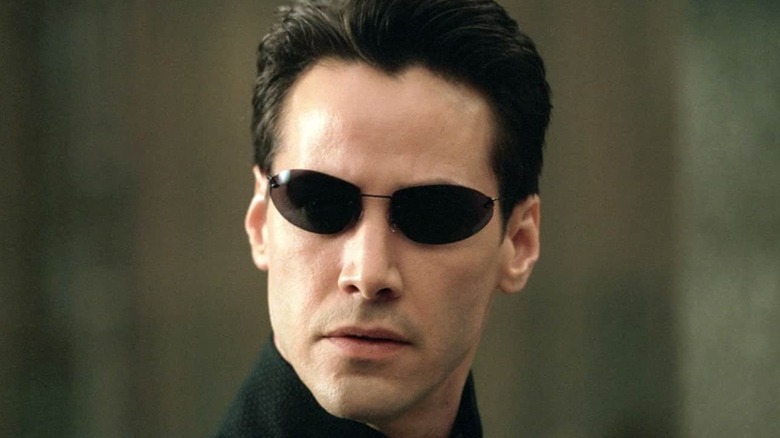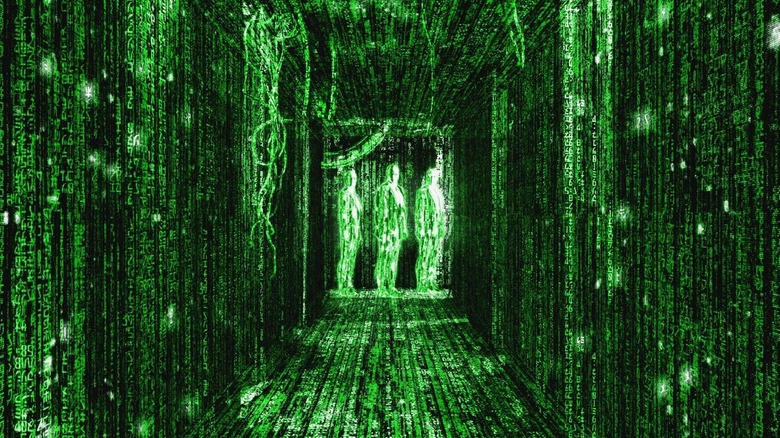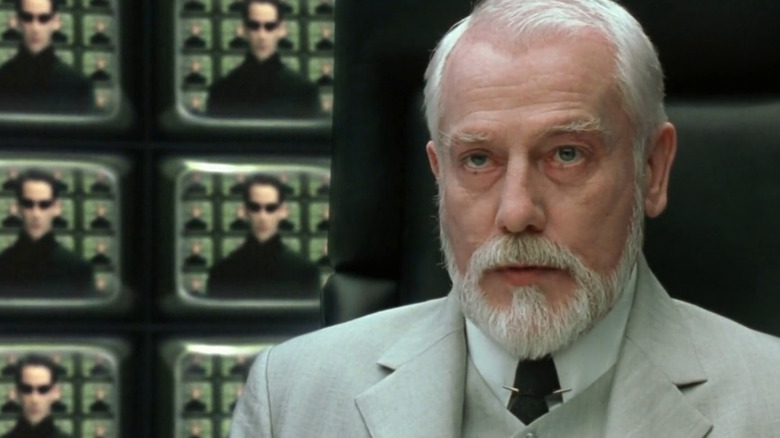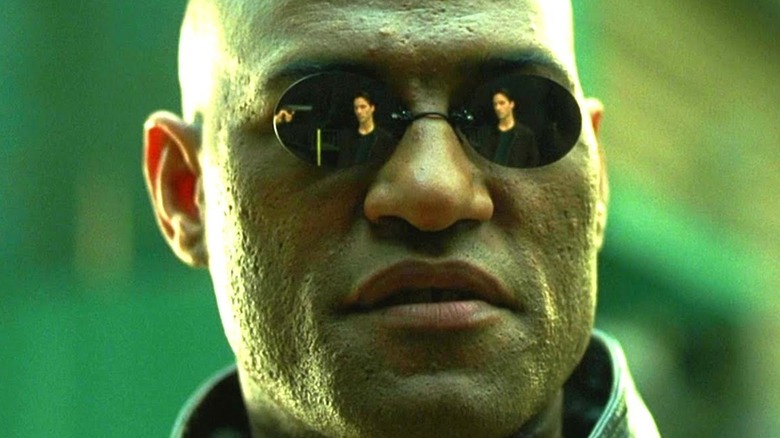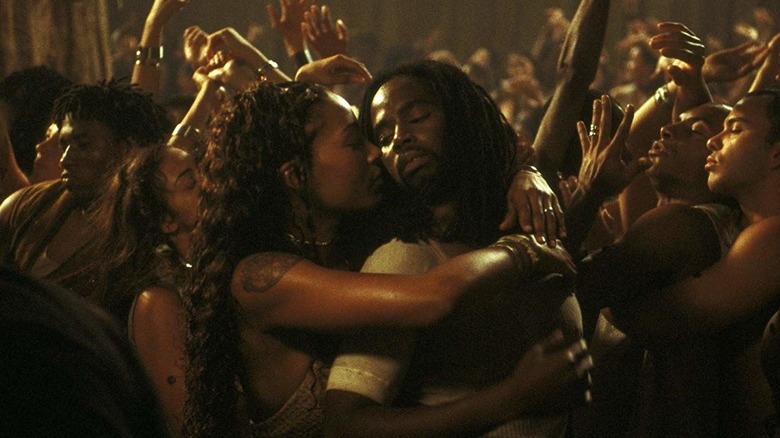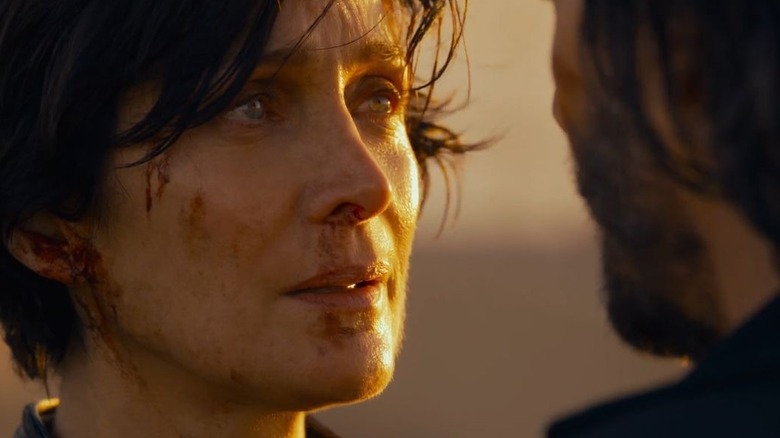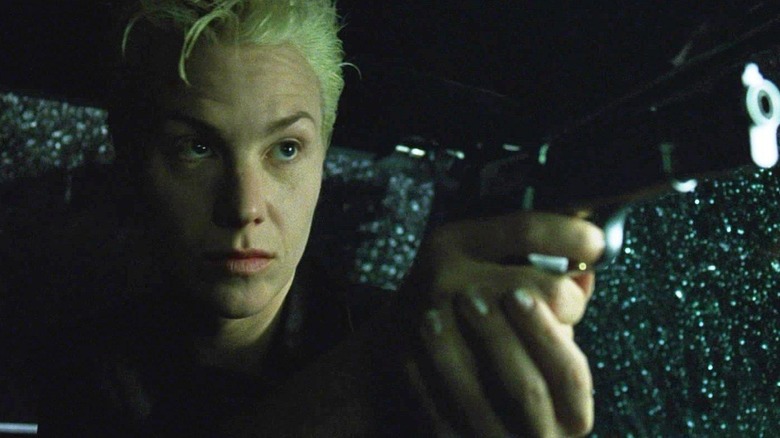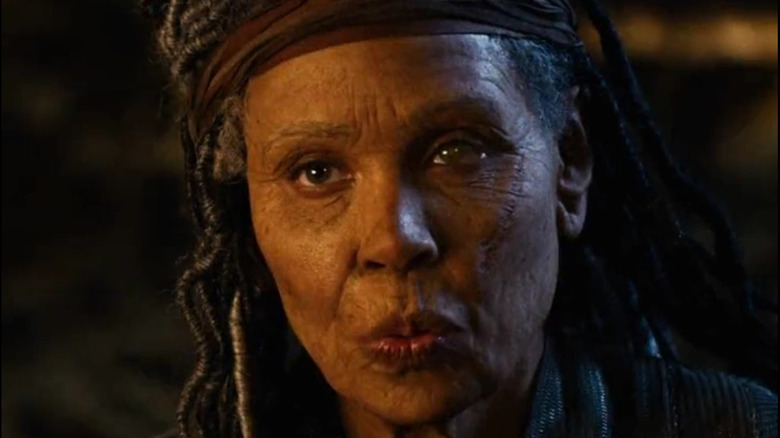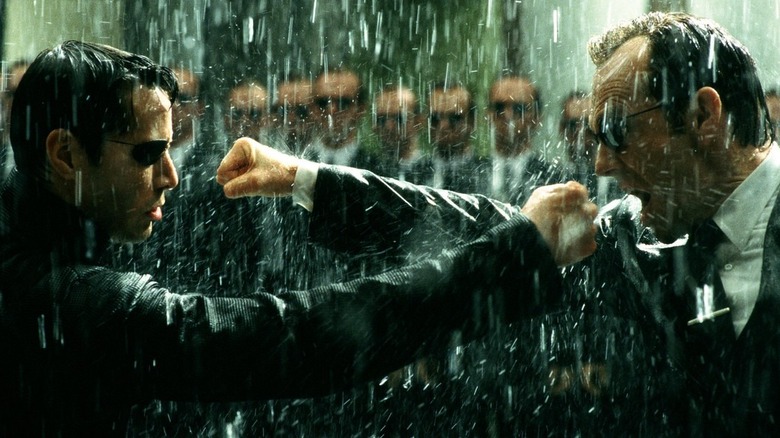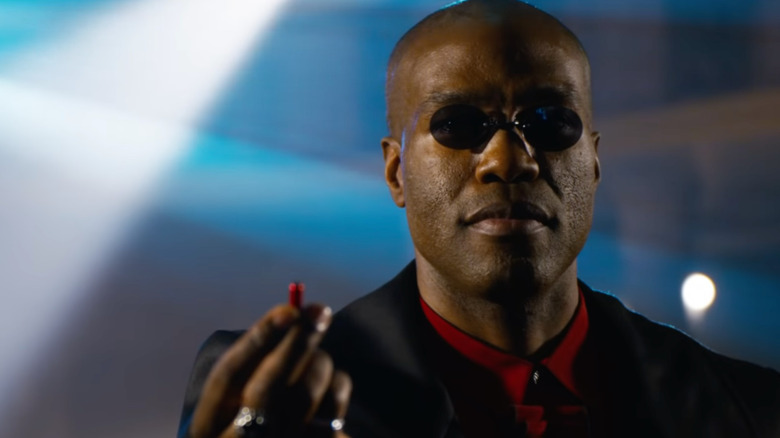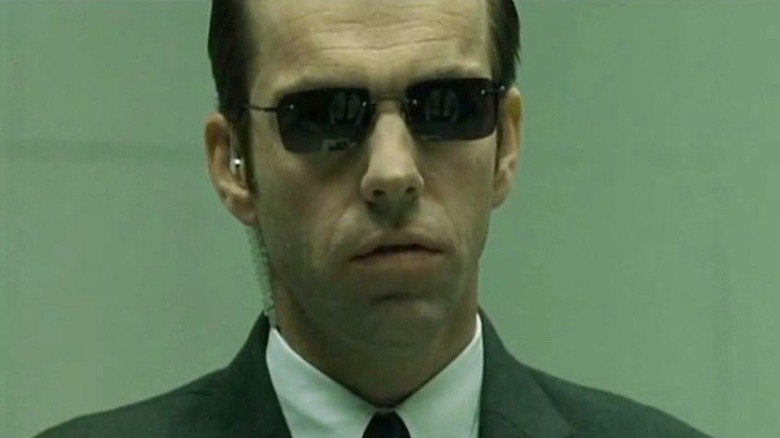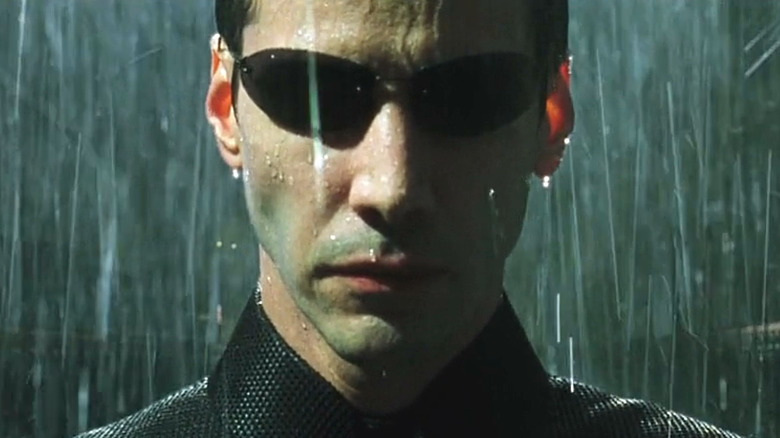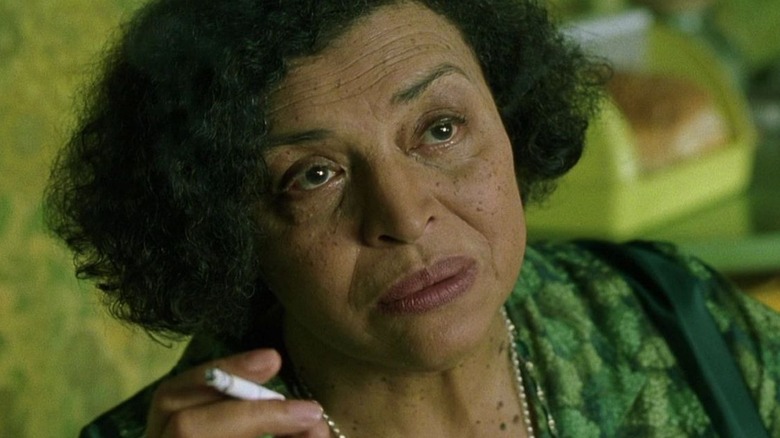The Biggest Themes In The Matrix Franchise Explained
In the great pantheon of science fiction movies, "The Matrix" stands alongside titans like "Star Wars," "Alien," and "Blade Runner" as one of the most influential franchises the genre has ever seen. Since the first film's release in 1999, "The Matrix" has been a staple of pop culture, spoofed and referenced just as often for its stylish cyber aesthetic as for its unique breed of slow-mo martial arts action. Beneath the veneer of leather and green code however, "The Matrix" is also a complex story that grapples with a number of deeper themes and ideas.
For most of its existence, "The Matrix" franchise has been quite divisive. One need only look at the reception to "The Matrix Resurrections" to see that the films are still quite polarizing today, per Rotten Tomatoes. In part, that divisiveness may be due to the density of movies themselves — movies that can be viewed in many different ways and through many different thematic lenses. More often than not, characters and plotlines in "The Matrix" are just as symbolic as they are literal, creating a textured narrative that's both uniquely compelling and frequently confusing, especially the first time through.
Though "The Matrix's" focus on philosophy and symbolism can make it a more convoluted viewing experience, it's also a big part of why the series has remained so relevant and appealing through the years. The Wachowski sisters have explored a lot of big ideas in the franchise, which are often left open-ended for the audience to consider on their own. Here are the biggest themes explored in the "Matrix" franchise, how they connect to each other, and how they play into the action of the films. There will be major spoilers ahead.
The dangers of technology in The Matrix
The actual backstory of "The Matrix" is pretty familiar in science fiction. Put simply, computers got too smart and took over the world. It's the same basic plot that drives "The Terminator" and many other films in the genre, but the way in which "The Matrix" explores this idea of malicious machinery is more unique. That method of exploration is, primarily, the Matrix itself — a digital realm that can be both an escape and a prison, depending on your point of view.
From the start, "The Matrix" warns against the dangers of A.I. and the risks of humanity becoming overly reliant on technology, but its commentary on digital development goes a bit deeper than a simple assessment of "computers are bad." In "The Matrix Resurrections," for example, a whole faction of machines and sentient programs is aligned with humanity, showing that a healthy relationship with technology is possible. This idea is explored in "The Matrix Reloaded" as well, when Councillor Hamann and Neo discuss how Zion itself can only exist with the help of complex machines.
These nuances play heavily into the franchise's overarching discussion of technology, suggesting that it's always human input that makes tools good or evil. The difference between a weapon of murder and a tool of defense is merely the decision of how to wield it, the series seems to say. All the power resides in the human choice.
Fate and determinism
Before talking about how choices play into the overall story of "The Matrix," it's important first to discuss fate. The "Matrix" timeline is riddled with prophecies, messianic figures, and discussions of destiny from the very beginning. The whole idea of "The One" relies on a belief in fate, and by the time Neo takes flight at the end of the original film, it seems that the prophecy was true. However, "The Matrix Reloaded" complicates that idea by revealing how "The One" was more manipulation than myth. When he meets with the Architect, Neo is informed that he's simply an anomaly — a part of the Matrix code that manifests every so often to change things up. Even the Oracle is revealed to be a program, and her apparent clairvoyance appears to be little more than a highly accurate algorithm calculating probabilities.
Still, the idea of fate persists, albeit in an altered form. If the Oracle can predict with such accuracy exactly what will happen based on pre-existing data, do people actually have free will, or are their paths determined by external forces? "Revolutions" and "Resurrections" seem to suggest that freedom still exists because humanity manages to buck the cycle, escape destruction, and evolve. Yet, events like Neo's victory and Zion's salvation all happen as foretold, leaving the question of destiny and determinism largely unanswered.
Choices
For every mention of fate in "The Matrix," there's a mention of choice. The red pill and the blue pill, which together have become the symbol for the entire series, represent the power and potential of human agency throughout all of the films, per The Conversation. Because determinism plays such a major role in the story, however, the validity of choices and free will are constantly called into question. The Oracle frequently tells Neo that he's already made choices before he actually makes them, suggesting that no decision truly belongs to any single person, as they've been influenced by external forces leading up to the moment of choice.
Despite these seeds of doubt, Neo seems to believe in his choices completely by the end of "The Matrix Revolutions." In his final battle against Smith, the program asks why Neo keeps fighting when all seems lost, to which he responds "because I choose to." The events of "Reloaded" show him that free will can always be constricted by forces of oppression and outside influences, but that doesn't remove the power from the act of choosing. The fact that Neo can decide to keep fighting in the face of everything that stands against him is a testament to his free will, regardless of the outcome.
In "The Matrix Resurrections," choices continue to be central to the plot. No matter how much time Neo has lost in his digital prison, or how far he has strayed from his old self, his free will still allows him to take control of himself again. No matter what forces are set against him, he can always choose to resist.
The Matrix and faith
Ultimately, "The Matrix" franchise leaves an ambiguous balance between the forces of fate and those of free will. Both are given credence at different points, and the two work together in myriad ways to form the complex narrative arc of the films. More often than not, these two themes are tied together within "The Matrix" by the idea of faith, which is a major motivator for many of the series' core characters.
Morpheus is perhaps the clearest example of a faith-motivated character in "The Matrix," as nearly everything he does is based on the (nearly) unshakeable belief that Neo is The One. Morpheus takes great risks under the guidance of his faith, showing the power such a strong belief can give a person. His station and reputation are less important to him than his core beliefs, and he often becomes a pariah for that reason.
Of course, Morpheus isn't the only instance of faith driving a character to great deeds in "The Matrix." Neo and Smith both achieve immense power because of their respective beliefs: Smith's in absolute nihilism and his own supremacy, and Neo's in the power of choice. For better or worse, there's rarely a more powerful motivator in "The Matrix" than faith. Faith in The One, faith in authority, faith in The Matrix itself — these all drive the core action of the films, revealing the strength and potential danger of unyielding faith.
What makes humans human
For all of the series' pontifications on technology, religion, gender, and authority, "The Matrix" is largely still a simple story about human emotion and desire. The Matrix itself becomes an unsatisfactory home for the humans within it because it robs them of the experiences that make them human in the first place: freedom, love, grief, triumph, joy, etc. Some of these feelings are still present in the simulation, but in muted, inauthentic forms. The series frequently asks what the difference is between humans and machines, though even that seemingly simple dichotomy becomes rather complicated later on.
The notorious rave scene in "The Matrix Reloaded" is a great example of the franchise's focus on uniquely human experiences and traits. Though the rave scene has often been criticized for its pointlessness, there's actually a huge importance embedded within it, via SyFy Wire. The rave represents what humanity is fighting for — the right to love, commune, and feel joy on their own terms and for their own reasons. The scene looks and feels notably different than the dance club scenes within the Matrix because of the freedom present in it.
As a whole, "The Matrix" doesn't rule out technology as a blatantly bad thing, but it cautions against developments that lead away from core human experiences like the ability to make your own choices, to celebrate life for the sake of life, and, of course, to love.
Love in The Matrix
While faith is one of the most powerful motivators in the "Matrix" franchise, it may not quite be the strongest of all. Many of the films' biggest moments come about in moments of love, generally represented by Neo and Trinity. There's an element of fate in their relationship, as there is an element of choice — the decision to make each other both more vulnerable and stronger by loving one another. Some of Neo's greatest feats, including saving Trinity's life within the Matrix and triumphing over Smith, are driven primarily by his love for Trinity.
In "The Matrix Resurrections," Neo and Trinity's love story quickly becomes the driving force of the film. It's revealed that their connection empowers both of them within the Matrix and that when they are united, they have nearly ultimate power to create or destroy. Is it all a little hokey? Yes, but "The Matrix" has never been much for subtlety. Human emotion is valued highly in the world of "The Matrix," and love stands as the ultimate expression of humanity. It makes sense then that Neo and Trinity's relationship, which is the ultimate symbol of love within the story, becomes the most powerful force in "Resurrections."
It's also worth noting that in the later films, certain machines and programs are shown to exhibit very human expressions of love, such as in the relationship between Sati and her father. It's as if the films are suggesting that it's the lack of love, not simply being a machine, that leads to dark places.
Gender identity
The Wachowski sisters have spoken up often about how "The Matrix" is filled with allegories for transness and gender identity, via Netflix Film Club. This can be seen clearly in the original film through the character of Switch, who was originally meant to be played by a male actor in the real world and a female actor in the Matrix. The character was ultimately changed to be played by the same actor in both realms, but their androgynous, fluid gender expression remained.
The whole idea of gender expression is explored in interesting ways through the Matrix's "residual self image" concept. As explained by Morpheus, the RSI is "the mental projection of your digital self." In other words, the way the Matrix works separates the body people are given in the real world and the way they actually see themselves. The residual self image is treated in the films as a true manifestation of a person's inner being, championing the idea that physiology and identity are far from the same thing.
In "The Matrix Resurrections," there are also a lot of references to binaries and their inherently restrictive nature, both regarding gender and other aspects of life. The game Neo is designing at the start of the film while still in his brainwashed state is called "Binaries," making the word a literal prison for his spirit. The Matrix itself, also a prison, is defined by binary code, meaning that the humans trapped within it are trapped within binaries. "Resurrections" even breaks down the binary between humans and machines, suggesting that there are many other ways to positively exist within the interstices of things.
Power structures and authority
There are clearly many different ways to view "The Matrix" films, but one of the more obvious ones is as a story of rebellion. To put it in "Star Wars" terms, the humans are the rebels and the machines are the evil empire. This is not necessarily a judgment that all power structures are inherently corrupt, but "The Matrix" does usually portray systems of authority as highly fallible and not worthy of trust. Lilly Wachowski has spoken out against fascism and authoritarianism numerous times, and that passion for people's empowerment and freedom shines through often in "The Matrix" (via them).
Because they serve as the main antagonists of the franchise, the Matrix and the machine hierarchy that maintains it are the clearest examples of corrupt power structures in the films. However, they aren't the only ones. Even the systems of human authority prove fallible multiple times. Certain members of the council and Zion's military adopt a defeatist mindset that would have gotten the city destroyed if not for the heroic acts of a select few. In "The Matrix Resurrections," Niobe — once one of those select few — has also grown complacent by way of fear and doubt. By telling these stories, "The Matrix" echoes the age-old adage that power, no matter who it's wielded by, will inevitably corrupt and blind.
More often than not, the heroes of "The Matrix" are those willing to subvert the power structures at hand to do what they know to be right. At the same time, the franchise still has many characters who do great things from positions of authority.
Hope and fear in The Matrix
The difference between a successful leader and a bad one in "The Matrix" often comes down to their worldview — do they approach the future with hope, or with fear and apathy? The series pays a lot of language to the idea that perseverance, a theme that's connected to the power of choice, is a force unto itself, but only those with the ability to hope in spite of dire circumstances are able to wield it.
This isn't exactly a boldly original theme to tackle in a story about oppression and resistance, but it's woven thoroughly through the "Matrix" films. The humans who make the most difference — Morpheus, Neo, Trinity, and their allies — are the ones who cling to hope. By contrast, the humans who falter in their efforts more often than not are the ones who make decisions out of fear. That includes the traitorous Cypher from the original film, as well as various members of Zion's leadership throughout the franchise.
A lack of hope can also be seen as one of the things that ultimately destroys Agent Smith (at least, until his "Resurrections" return). By the end of "The Matrix Revolutions," he's only interested in absolute oblivion, unable to envision any better of a world for himself or anyone else. Smith's nihilism isn't what ultimately destroys him, but it certainly sets him down a path where Neo's hope and undying determination give him the clear advantage.
Prejudice
Throughout the "Matrix" films, there's a running theme of prejudice explored in the relationship between humans and machines. At first, there's not much nuance there, as the whole digital world acts as a villain to humanity at the star. However, as the films continue, more and more humanesque, sympathetic, and compassionate programs are introduced, building to a full-on merging of the human and machine societies in "The Matrix Resurrections."
There's not necessarily a ton of complexity in the "Matrix" message that you shouldn't judge a book by its cover, but it's one more way the films explore the dissolution of binaries and the ways hard labels can create harm. Once again, it's not the physical being of someone — human or machine, for instance — that defines their impact and value. Rather, it's the choices they make, why they make them, and how they leverage their own power for good or evil.
Addiction
It's mostly metaphorical, but there's a running theme of addiction in "The Matrix" movies, especially "The Matrix Resurrections." The visualization of the digital world's alluring control in the form of red and blue pills was established in the original film, but the series' fourth installment heightens the metaphor by turning blue pills into a prescription and creating some clear parallels with America's modern opioid epidemic (via Slate).
The Matrix's status as both escape and prison can certainly be read as a representation of addiction in a broad sense. Its connection can be incredibly hard for some to sever, especially given the grim and depressing nature of the real world outside the endless green code. For the most part, however, "The Matrix" films don't offer much overt commentary on this parallel, simply allowing the metaphor to stand in the background as another layer of the series' deeply textured story.
Media and propaganda
The negative effects of overexposure to media are explored thoroughly in "The Matrix Resurrections" and to a lesser degree in the preceding films. The Matrix itself can be seen as one giant symbol of propagandist media: an all-encompassing world designed to subdue and control the populace. In "Resurrections," that symbol is simply expanded to include concepts like interactive entertainment, social media, and cultural dominance of franchises like "The Matrix."
Obviously, the metaphor is kept pretty black-and-white because the Matrix is pretty exclusively a bad thing. There isn't much discussion of different levels of bias or positive use of media because those things simply aren't present in the movies' digital world. Still, even without much nuance, "The Matrix" offers a powerful warning of what can become of media when forces of oppression and corruption wield it to their whims.
Collectivism vs. individuality
In its story of warring factions and fractured communities, "The Matrix" explores ideas of individuality and collectivism. Zion has a clear collectivist structure in which all citizens fulfill some greater obligation to the group as a whole. In the final battle for the city in "The Matrix Revolutions," everyone who can fight suits up unquestioningly to meet the rising enemy. Even before things get that dire, Zion is shown to be a place of great equity — a place where everything is shared, where people take care of each other because they're all they have left.
While that all seems to endorse collectivism, "The Matrix" films also put a strong amount of support behind individuality. Smith's conquest of the Matrix takes the form of him assimilating every other program, turning them all into identical versions of himself. While plugged into the Matrix, all humans look basically identical and serve the exact same purpose to the machines. In "Resurrections," there are zombie-like bots within the Matrix who swarm at intruders in horrifying, brainless attacks. For the most part, these instances of individuality being lost are portrayed as inherently evil.
By holding up both collectivism and individuality in tandem, "The Matrix" seems to seek a sort of balance — a system where individuals serve the needs of the group selflessly, while still holding onto their own autonomy and the things that make them unique.
Balance in The Matrix
If there's one theme that persists through all the other ideas explored in the "Matrix" franchise, it's that balance is a delicate but necessary thing. The series is filled with dangerous binaries: binaries of identity, of behavior, even of societal structure. But generally, the solutions, or at least the best-case scenarios, are found in the space between the two extremes. Is Neo driven by fate, or is he the master of his own destiny? Maybe a little bit of both in the end. Zion was a city focused only on survival, but with the help of machines and programs, IO becomes a city that thrives and focuses on the future in "Resurrections." The right thing in the series is usually to forge a new path, find a middle way, or reconcile two seemingly opposite ideas with one another.
"The Matrix" story works well because it operates on both simple and complex levels. Each of its themes can be explored in immense depth, but the films can also be viewed as more easily digestible adventure stories. There are always evil forces that will seek to oppress and control, and there will always be hope in resistance when freedom, choice, cooperation, and true expression of self are employed. It should be exciting to see how all those ideas continue as the "Matrix" franchise moves forward.
